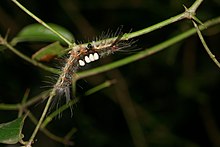Lymantriinae
| Lymantriinae | |
|---|---|
 |
|
| Orgyia sp. | |
| Scientific classification | |
| Kingdom: | Animalia |
| Clade: | Euarthropoda |
| Class: | Insecta |
| Order: | Lepidoptera |
| Superfamily: | Noctuoidea |
| Family: | Erebidae |
| Subfamily: |
Lymantriinae Hampson, 1893 |
| Diversity | |
| About 350 genera, 2,500–2,700+ species |
|
| Synonyms | |
|
|
The Lymantriinae (formerly called the Lymantriidae) are a subfamily of moths of the Erebidae family.
Many of its component species are referred to as "tussock moths" of one sort or another. The caterpillar, or larval, stage of these species often has a distinctive appearance of alternating bristles and haired projections. Many tussock moth caterpillars have urticating hairs (often hidden among longer, softer hairs), which can cause painful reactions if they come into contact with skin.
The subfamily Lymantriinae includes about 350 known genera and over 2,500 known species found in every continent except Antarctica. They are particularly concentrated in sub-Saharan Africa, India, Southeast Asia, and South America. One estimate lists 258 species in Madagascar alone. Apart from oceanic islands, notable places that do not host lymantriines include the Antilles and New Caledonia.
Adult moths of this subfamily do not feed. They usually have muted colours (browns and greys), although some are white, and tend to be very hairy. Some females are flightless, and some have reduced wings. Usually, the females have a large tuft at the end of the abdomen. The males, at least, have tympanal organs. They are mostly nocturnal, but Schaefer lists 20 confirmed diurnal species and 20 more likely diurnal species (based on reduced eye size).
The larvae are also hairy, often with hairs packed in tufts, and in many species the hairs break off very easily and are extremely irritating to the skin (especially members of the genus Euproctis). This highly effective defence serves the moth throughout its lifecycle. The hairs are incorporated into the cocoon. An emerging adult female of some species collects and stores the hairs at the tip of the abdomen and uses them to camouflage and protect the eggs as they are laid. In other species, the eggs are covered by a froth that soon hardens or are camouflaged by material the female collects and sticks to them. In the larvae of some species, hairs are gathered in dense tufts along the back and this gives them the common name of tussocks or tussock moths.
...
Wikipedia
